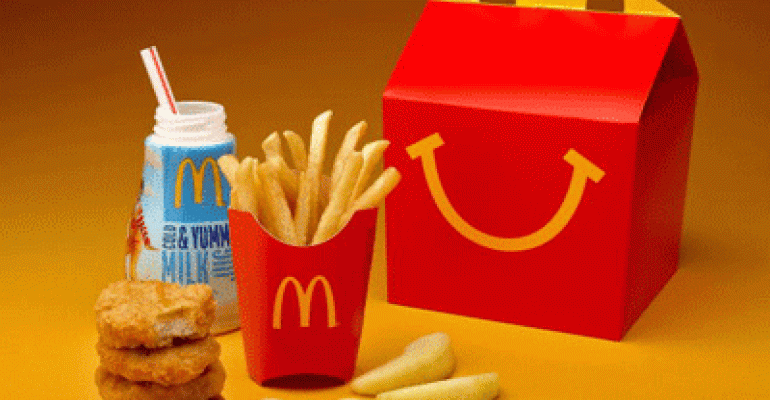Economic pressures, government regulations and more discerning palates among children continue to cut into sales of kids’ meals in the restaurant industry, according to new research from consumer market research firm The NPD Group.
For the year ended December 2011, restaurant visits that included the purchase of a kids’ meal with a toy declined 6 percent compared with the previous year. Orders of regular kids’ menus also fell 1 percent for that period, and visits including the purchase of an older-kids’ meal decreased 16 percent, the research found.
An overall decline in restaurant traffic from families contributed greatly to the decrease in kids’ meal sales, especially to quick-service brands, according to NPD. In 2006 — the last year visits including kids’ meals with toys increased — there were 21 billion restaurant visits from parties with children, including 17 billion visits to quick-service outlets. In 2011, traffic from parties with children declined to 19.5 billion visits, of which 15 billion were to a quick-service location.
Changing tastes among children also led to fewer kids’ meal sales, said Bonnie Riggs, restaurant industry analyst for Port Washington, N.Y.-based NPD Group. “In addition to the economic factor, kids have become more sophisticated, and just like adults, they want to try new things and new foods,” she said. “Kids have a wider variety of foods and flavors available to them than they have in the past.”
She projected that restaurant chains would continue to substitute more healthful foods for standard menu items in kids’ meals, including beverages, where high-sugar options like carbonated soft drinks would give way to more milk and bottled water. Regular-size burgers and sandwiches also would roll off kids’ meals in favor of miniature versions or chicken wraps, while side items would include more fruit than regular-size French fries, she said.

Government regulation and pressure from consumer advocacy groups also have necessitated a proactive response from the restaurant industry related to the content of kids’ meals and the way they are marketed.
In March, the nation’s largest seller of kids’ meals, McDonald’s, updated its advertising campaign for Happy Meals to accentuate further the importance of healthful food choices and active lifestyles. The brand also launched Champions of Play, an initiative to promote involvement in youth sports, as part of its Olympic Games sponsorship.
Both McDonald's and Burger King said in December 2011 that they'd sell toys with kids' meals for 10 cents at their San Francisco locations instead of automatically including them for free — a response to that city’s ban on kids’ meal toys.
Before that, McDonald's was dealing with pressure from the Center for Science in the Public Interest, a watchdog group that sued McDonald’s for deceptive marketing practices toward children December 2010. The group argued that free Happy Meal toys induced children and their parents to buy unhealthful food, but that suit was dropped the following April.
Most recently, the National Restaurant Association has promoted its child-nutrition initiative Kids LiveWell, which earned the praise of former President Bill Clinton during his keynote speech at the 2012 NRA Restaurant, Hotel-Motel Show in Chicago. Chains including Au Bon Pain, Burger King, Chili’s, Cracker Barrel and Outback Steakhouse were among the first to sign on to Kids LiveWell, while Applebee’s, Chick-fil-A, Mimi’s Café, First Watch and Which Wich have joined the initiative in the past three months.
“Kids are different today than they were a decade ago: They want to grow up fast and don’t want to be thought of as kids,” Riggs of The NPD Group said. “Moms are also more concerned with the foods that their kids are eating. Restaurant operators and foodservice manufacturers understand this and are offering more varied options on kids’ menus, downsized portions and healthy alternatives.”
Contact Mark Brandau at [email protected].
Follow him on Twitter: @Mark_from_NRN





